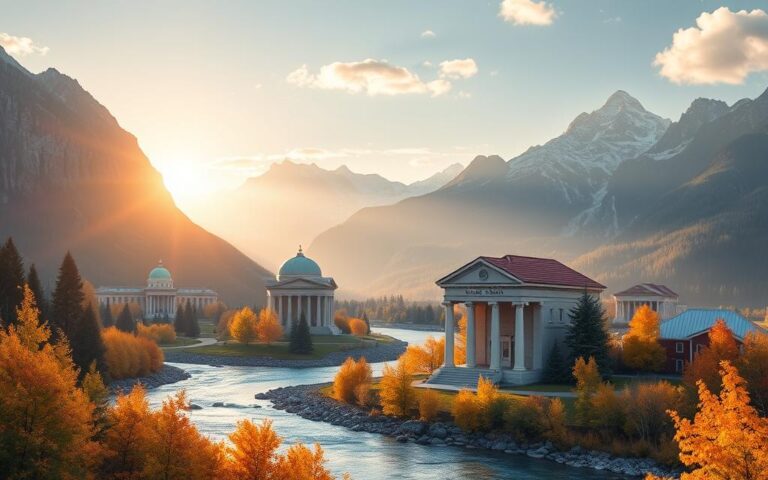adversiment
In 2022, Canada’s personal loan market hit $326 billion. This shows the wide range of loan options for Canadians. These loans cater to various financial needs and situations.
From personal loans to secured and unsecured options, Canadians have many lending choices. These options help people seeking financial assistance for different reasons.

Let’s explore the different types of loans in Canada. We’ll look at their features and what to consider when choosing.
This guide will help you make informed decisions about loans. You’ll learn which options suit your financial goals best.
Overview of Loans in Canada
Loans are vital in Canada’s financial world. They help people and businesses reach their goals. Understanding loans is key to making smart money choices.
What is a Loan?
A loan is money borrowed from a lender. You agree to pay it back with interest over time. Lenders can be banks, credit unions, or online financial firms.
Loans provide funds for various needs. These can include buying a home or growing a business.
Importance of Loans in Financial Planning
Canadian loans are crucial for financial planning. They give access to funds that might not be readily available. This helps with investments, unexpected costs, or debt consolidation.
Smart use of loans can boost long-term financial health. It’s true for both individuals and businesses.
Knowing the various loan options Canada offers is essential. It helps you make choices that match your personal or business aims.
“Loans are the keys that unlock the doors to financial opportunities and empower Canadians to achieve their dreams.”
Types of Loans Offered in Canada
Canada offers many loan options to meet your financial needs. These include personal, secured, and unsecured loans. Let’s look at each type’s key features.
Personal Loans
Personal loans are great for various purposes like debt consolidation or home renovations. Banks, credit unions, and online lenders offer these loans. They can be customized to fit your financial needs.
Secured Loans
Secured loans require collateral, such as a home or vehicle. They often have lower interest rates than unsecured loans. However, you risk losing your collateral if you can’t make payments.
Unsecured Loans
Unsecured loans don’t need collateral. They’re based on your creditworthiness. These loans are used for personal expenses or small business funding.
Unsecured loans may have higher interest rates. But they offer more flexibility. They also don’t put your assets at risk.
Knowing these loan types helps you make smart financial choices. Consider your needs carefully. Choose the loan that fits your unique situation best.
| Loan Type | Collateral Required | Interest Rates | Flexibility |
|---|---|---|---|
| Personal Loans | No | Moderate to High | Flexible |
| Secured Loans | Yes | Low to Moderate | Less Flexible |
| Unsecured Loans | No | High | Flexible |
Popular Personal Loan Options in Canada
Canadians have many personal loan options to choose from. These include traditional banks, credit unions, and online lenders. Each option has its own features and benefits.
Understanding these choices helps borrowers make informed decisions. They can find loans that meet their financial needs and goals.
Bank Personal Loans
Canadian banks offer various personal loan products with flexible terms. They often have competitive interest rates for existing customers. However, banks may have strict eligibility criteria.
The approval process can be longer compared to other options. But for many, banks remain a reliable choice for personal loans.
Credit Union Personal Loans
Credit unions are member-owned financial cooperatives. They typically offer lower interest rates on personal loans. Their service is often more personalized, tailoring loans to individual needs.
The application process at credit unions is usually streamlined. This makes them attractive for those seeking community-focused lending experiences.
Online Lenders
Financial technology has led to more online lenders in Canada. These digital platforms offer quick and convenient loan applications. They often provide faster approval and funding processes.
Online lenders may have more flexible eligibility requirements. They also offer a wide range of personal loan products. However, borrowers should carefully review terms and conditions.
When exploring personal loans Canada and loan options Canada, consider several factors. These include interest rates, repayment terms, fees, and lender reputation.
Compare options carefully to find the best personal loan. This will help you choose a loan that fits your financial situation.
Government-Supported Loan Programs in Canada
The Canadian government offers several loan programs to support citizens at different financial stages. These programs provide affordable financing options. They empower Canadians to achieve their goals.
Canada Student Loan Program
The Canada Student Loan Program is a vital resource for post-secondary students in Canada. It provides financial aid to eligible students for tuition, living expenses, and other education costs. The program offers competitive interest rates and flexible repayment terms.
First-Time Home Buyer Incentive
The First-Time Home Buyer Incentive makes homeownership more accessible for first-time buyers in Canada. This program offers an interest-free loan of up to 10% of the home’s purchase price. It reduces the required down payment and monthly mortgage payments.
Emergency Assistance Loans
- The Canadian government offers Emergency Assistance Loans for unexpected financial hardships. These loans help individuals and families cope with unforeseen events like natural disasters or job loss.
- The application process is quick, and funds are provided promptly. Repayment terms are flexible to help borrowers regain financial stability.
These loan programs show the government’s commitment to supporting citizens’ diverse financial needs. They can be valuable resources in your financial planning journey.
Understanding Secured Loans
Secured loans in Canada require collateral from borrowers. This can be a house, car, or investment accounts. Collateral guarantees loan repayment, making secured loans popular for financial assistance.
Definition and Security
Secured loans are backed by assets or property called collateral. This guarantees the borrower will repay the loan. If payments are missed, lenders can seize and sell the collateral.
Benefits of Secured Loans
- Lower interest rates: Secured loans generally have lower interest rates compared to unsecured loans, as the collateral reduces the lender’s risk.
- Higher loan amounts: Borrowers can typically obtain larger loan amounts with secured loans, as the collateral provides the lender with a safety net.
- Improved credit access: Individuals with poor credit or limited credit history may find it easier to qualify for a secured loan, as the collateral reduces the lender’s risk.
Risks Associated with Secured Loans
Secured loans have risks despite their benefits. The main risk is losing collateral if payments are missed. This can lead to losing valuable assets like homes or vehicles.
Secured loans may require longer repayment periods. This can increase the overall cost of borrowing over time.

Using assets to secure loans can be a powerful financial tool. However, borrowers must consider the risks and obligations carefully. Understanding secured loans helps Canadians make smart financial choices.
Exploring Unsecured Loans
Unsecured loans are gaining popularity among Canadians seeking extra funds. These loans don’t require collateral, unlike secured loans. Approval is based on creditworthiness and income, making them attractive to those without assets.
Characteristics of Unsecured Loans
Unsecured loans in Canada have distinct features. They don’t need asset pledges as collateral. Lenders assess credit history, employment, and financial profiles to determine risk.
These loans typically have higher interest rates than secured loans. This is because they pose more risk to lenders.
Pros and Cons of Unsecured Loans
Personal loans Canada that are unsecured offer both benefits and drawbacks. They provide access to funds without collateral, offering flexibility for those lacking assets.
The application process is often quicker and simpler than secured loans. However, higher interest rates and potential credit score impacts need careful consideration.
| Pros of Unsecured Loans | Cons of Unsecured Loans |
|---|---|
| No collateral required Faster application process Flexibility in how the funds are used | Higher interest rates Potential impact on credit score Stricter eligibility criteria |
Understanding these features helps Canadians make informed decisions about unsecured loan Canada options. Weighing pros and cons is crucial for choosing the right financial solution.
The Role of Interest Rates in Canadian Loans
Interest rates greatly affect Canadian loans. Fixed and variable rates are the two main types. These rates impact loan costs, repayment terms, and borrower budgeting.
Fixed vs. Variable Rates
Fixed-rate loans keep the same interest rate throughout the loan. This gives borrowers steady monthly payments. Variable-rate loans have changing interest rates based on market conditions.
Variable rates can lead to different monthly payments over time. This makes budgeting less predictable for borrowers.
Factors Influencing Interest Rates
Many factors affect interest rates on Canadian loans. These include:
- The Bank of Canada’s benchmark interest rate
- Economic conditions, such as inflation and GDP growth
- The borrower’s credit profile and risk profile
- The type of loan and its terms, such as the loan amount and repayment period
These factors shape the rates lenders offer. They determine the overall cost of loans for Canadian borrowers.
Lenders use these factors to set competitive yet profitable rates. This balance affects loan affordability for Canadians.
“Understanding the interplay between interest rates and loan options is crucial for Canadians to make informed borrowing decisions that align with their financial goals and circumstances.”
How to Choose the Right Loan Option
Finding the best loan in Canada requires careful evaluation of your finances. Compare available options to align with your needs and goals. This approach ensures you select the most suitable loan.
Assessing Your Financial Situation
Examine your current financial standing closely. Look at your income, debts, credit score, and upcoming financial obligations. This assessment helps determine the loan amount and terms that fit your budget.
Comparing Loan Features
- Interest rates: Compare fixed and variable interest rates to find the most favorable option.
- Loan terms: Evaluate the repayment period and how it aligns with your financial goals.
- Fees and charges: Understand any upfront or ongoing fees associated with the loan.
- Flexibility: Consider the loan’s prepayment options and whether it allows for early repayment without penalty.
Understanding Terms and Conditions
Review each loan option’s terms and conditions carefully. Check the lender’s requirements, collateral needed, and any restrictions or limitations. Make sure you understand the loan agreement fully before signing.
| Loan Option | Interest Rates | Loan Terms | Fees and Charges |
|---|---|---|---|
| Bank Personal Loan | 5.99% – 19.99% | 1 to 7 years | Origination fee: 1% – 5% |
| Credit Union Personal Loan | 4.99% – 17.99% | 1 to 5 years | No origination fee |
| Online Lender Personal Loan | 6.99% – 29.99% | 1 to 5 years | Origination fee: 2% – 8% |
Evaluate your finances, compare loan features, and understand the terms. This helps you choose the best loan options in Canada for your needs. Make an informed decision to meet your financial goals.
Tips for Loan Applications in Canada
Applying for a loan in Canada can be challenging. But with proper preparation, you can boost your success chances. Here are key tips for Canadian loans and personal loans in Canada.
Required Documentation
Have these documents ready for a smooth application process:
- Proof of income, such as pay stubs, tax returns, or bank statements
- Identification documents, such as a driver’s license or passport
- Information about your assets and liabilities, including any existing loans or credit card balances
- Details about the purpose of the loan, such as a home purchase or debt consolidation
Improving Your Credit Score
Your credit score affects loan eligibility and interest rates. To boost your score, try these strategies:
- Review your credit report and address any errors or discrepancies
- Make all your payments on time, including credit card bills and existing loans
- Reduce your credit card balances and keep your credit utilization low
- Avoid applying for multiple loans or credit cards in a short period
Common Mistakes to Avoid
Be aware of these pitfalls when applying for a Canadian loan or personal loan in Canada:
- Failing to provide accurate and complete information on the loan application
- Not shopping around and comparing offers from multiple lenders
- Forgetting to factor in all the associated fees and charges, such as origination fees or prepayment penalties
- Neglecting to read and understand the terms and conditions of the loan agreement
Follow these tips to boost your chances of securing the right loan. Careful preparation can make a big difference.
Pay attention to details throughout the process. This will help you find a loan that fits your needs.
Repayment Strategies for Canadian Loans
Managing Canadian loans can be tricky, but smart repayment strategies can help. These tips will guide you through personal loans and debt consolidation. You’ll learn to handle your financial duties with ease.
Creating a Repayment Plan
Start by making a detailed repayment plan. Review your loan terms, interest rates, and monthly payments. Prioritize your loans and budget wisely to ensure timely, full payments.
Understanding Prepayment Options
Many Canadian lenders allow early loan payoffs. This can save you money on interest and help you become debt-free faster. Check for fees or penalties before using these options.
Also, consider how prepayment might affect your credit score. It’s important to weigh all factors before deciding.
Dealing with Financial Hardship
If you’re struggling with payments, act fast. Contact your lender and explain your situation. They might offer temporary payment deferment or loan modification.
Remember, open communication is key. A proactive approach can help you navigate financial challenges effectively.
These strategies can help you control your Canadian loans and build financial stability. Whether you’re exploring debt consolidation loans or managing multiple personal loans Canada, make informed choices. You’ll be on your way to achieving your financial goals.
Conclusion: Making Informed Loan Decisions
Choosing the right loan in Canada requires careful thought and expert guidance. Loan types and terms vary widely. Making a smart choice is key to reaching your money goals.
Research different loans, interest rates, and repayment plans thoroughly. This knowledge will help you pick the best option for your needs.
Compare offers from banks, credit unions, and online lenders. This way, you’ll find the most favorable terms for your loan.
Importance of Research
Dive deep into personal, secured, and unsecured loans. Understanding these will help you choose the best fit for your finances.
Look at various lenders and their offers. This comparison will help you get the most value from your loan.
Seeking Professional Advice
Financial experts can boost your decision-making when choosing loans in Canada. They offer valuable insights and help with complex loan applications.
A qualified advisor can guide you to the right loan for your long-term money goals. They can assess your credit score and explore government-supported loan programs for you.
Their expertise is crucial in evaluating repayment strategies. This ensures you’re on the right track with your loan choice.
FAQ
What is a loan?
A loan is borrowed money from a lender. It’s repaid over time, usually with interest. Lenders can be banks, credit unions, or online platforms.
Why are loans important in financial planning?
Loans provide access to funds for various purposes. They help finance major purchases, consolidate debt, or start businesses. Loans bridge financial gaps and help achieve goals.
What are the main types of loans offered in Canada?
Canada offers personal, secured, and unsecured loans. Each type has unique characteristics and benefits. Borrowers should consider these when choosing a loan.
What are the sources of personal loans in Canada?
Canadians can get personal loans from banks, credit unions, and online lenders. Each option has different features, interest rates, and approval processes. Consider these when choosing a loan.
What are some government-supported loan programs in Canada?
Canada offers several government-supported loan programs. These include the Canada Student Loan Program and First-Time Home Buyer Incentive. Emergency assistance loans are also available for specific borrowing needs.
What is a secured loan, and how does it differ from an unsecured loan?
Secured loans require collateral, like a home or vehicle. Unsecured loans don’t need collateral but may have higher interest rates. They also have stricter eligibility criteria.
Your choice depends on your financial situation and needs.
What are the differences between fixed and variable interest rates on Canadian loans?
Fixed-rate loans have a constant interest rate throughout the loan term. Variable-rate loans can fluctuate based on market conditions. Your choice depends on risk tolerance and interest rate expectations.
How can I choose the right loan option for my needs?
Assess your financial situation and compare different loan products. Understand the costs and conditions associated with each option. Seek professional advice to make an informed decision aligned with your goals.
What documentation is required when applying for a loan in Canada?
Loan applications typically need identification, income proof, and employment information. Details about the loan’s purpose are also required. Lenders may ask for additional documents based on the loan type.
How can I effectively manage the repayment of my Canadian loan?
Create a realistic repayment plan and use prepayment options when possible. Address any financial hardships that arise during the loan term. Consider debt consolidation to simplify repayment if you have multiple loans.



